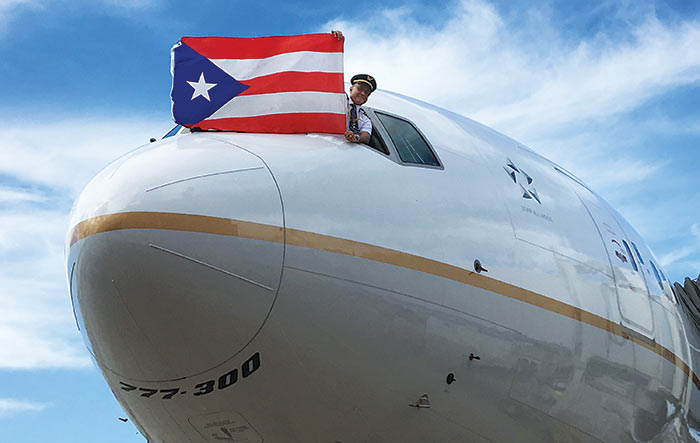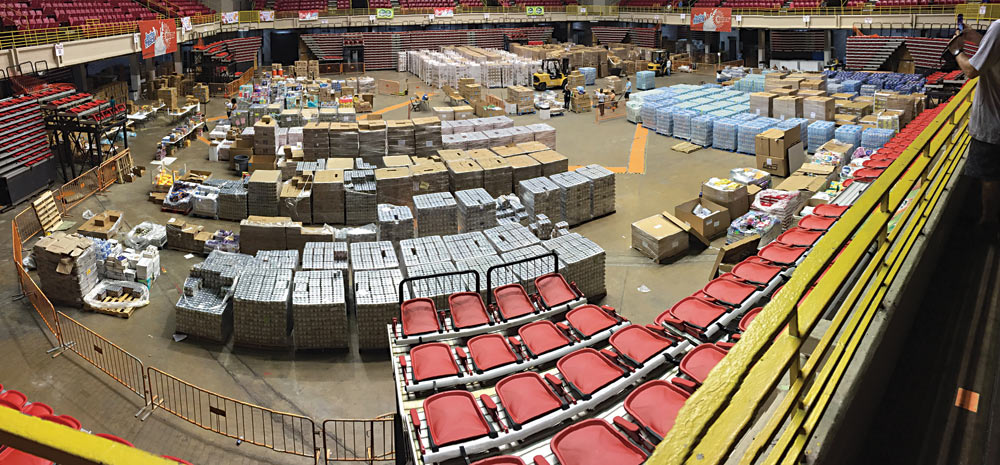Flying Heroes: ALPA Pilots Deliver Aid to Hurricane-Ravaged Puerto Rico
By John Perkinson, Senior Staff Writer

F/O José Raices (United) holds a Puerto Rican flag from outside the cock-pit window at Puerto Rico’s Luis Muñoz Marín International Airport.
On October 4, United Airlines Flight 2709 transported more than 300 AFL-CIO skilled workers from more than 20 labor unions to Puerto Rico to voluntarily assist with its recovery efforts after Hurricane Maria destroyed much of the Caribbean island. In addition to the carpenters, electricians, health-care professionals, and many others, the aircraft hauled 35,000 pounds of donated necessities including food, water, medicines, generators, and other goods.
To convey this aid package, ALPA teamed up with the Association of Flight Attendants–CWA, the International Association of Machinists and Aerospace Workers, and United Airlines to furnish a Boeing 777-300ER—free of charge—along with volunteer pilots, flight attendants, and ramp workers to make this unique mission of mercy possible.

Thousands of pounds of donated items—including food, water, medicines, generators, and other goods—are readied for delivery to residents of Puerto Rico.
Connections
Frustrated by both the extent of the hurricane damage and the need for immediate assistance, San Juan Mayor Carmen Yulín Cruz, encouraged by Puerto Rican labor leaders, called AFL-CIO President Richard Trumka on September 26 to see if he could provide assistance. The two talked about the possibility of transporting U.S. continental laborers to the disaster area to help.
Capt. Todd Insler (United), his pilot group’s master executive council (MEC) chairman, was soon contacted. A member of United Continental Holding, Inc.’s Board of Directors, Insler proved instrumental in reaching out to other airline officials to get their buy-in to authorize and coordinate this effort.
“Our fellow Americans in Puerto Rico need help, and this is a race against time,” Insler stated. “The ALPA pilots of United Airlines are proud to fly these skilled workers and medical professionals to San Juan and will continue to support humanitarian efforts going forward.”
Commenting on this landmark undertaking, Capt. Tim Canoll, ALPA’s president, remarked, “This is a classic example of what can happen when labor and management work together. And thanks to this joint effort combined with the many AFL-CIO skilled workers who contributed their time, our fellow citizens in Puerto Rico were the beneficiaries.”
Leveling wind
The word “catastrophic” doesn’t begin to describe the extent of the destruction Maria exacted on Puerto Rico. The Category 4 storm slammed into the U.S. territory on September 20, causing an estimated $85 billion in damage. Homes, businesses, and much of the local infrastructure were destroyed.
Recovery efforts were already stretched thin following the destruction brought on from Hurricanes Harvey in Texas and Irma in Florida. Consequently, fewer Federal Emergency Management Agency (FEMA) workers were available, and Puerto Rico was forced to compete with these other affected communities for charitable donations.
Complicating matters, San Juan’s Luis Muñoz Marín International Airport was rendered incapacitated. Hangars were mangled, many of the windows in the terminals were knocked out, and the waterlogged facility had no power. Three days later, the airport reopened but on an extremely limited basis.
Enlisting volunteers
Pilots volunteering to fly the AFL-CIO mission included Capt. José Pascual (United), who serves as the Local Council 5 central air safety chair, and F/O Michael Hamilton (United), one of ALPA’s executive vice presidents.
Because of the long duty day, the two would need to deadhead for the return flight. Subsequently, Capt. Alan Moses (United) and F/O José Raices (United) agreed to deadhead to San Juan to fly the second leg of the journey.
Of the four, only Hamilton had flown to Puerto Rico since Maria. Traveling just six days after the immense weather system hit, he noted there was still no power at the airport and, consequently, no air conditioning. “The temperature was pushing 100 degrees Fahrenheit in the terminal,” he said.
“The damage to the airport was shocking,” he recalled, adding “Certain parts of the tarmac were unstable because of flooding, and hardly anything was operational.” Flights had to be separated by time over the fixes inbound to the airport. The United crew employed an RNAV approach, using GPS to guide them in the final stages of the flight.
Of this previous journey, Hamilton said that he and the crew transported 366 evacuees on the return flight. As he walked down the jetway after parking at the gate, “One of the passengers thanked me for ‘rescuing’ her, which made the importance of these humanitarian flights hit home,” he said, adding, “numerous people were crying on their way out.”
Hamilton observed that customer service agents, members of the clergy, Red Cross volunteers, and paramedics stood ready to attend to the disembarking hurricane victims.
Departure time
On the morning of October 4, Newark Liberty International Airport’s Gate C110 was packed with volunteers ready to embark on the relief mission. News reporters interviewed the union workers, many of whom had ties to Puerto Rico.
Flight planning for a disaster area requires some additional considerations. The amount of jet fuel to load for the first flight would depend on what was available at the airport for the return trip. NOTAMs changed daily, based on conditions at the airport, and planning for alternate airfields was also a concern because some of the nearby facilities weren’t available. With their prefight checklist completed, the pilots pulled the aircraft away from the terminal about 11:00 a.m.
Pascual and Hamilton described the nearly three-hour-and-45-minute flight as routine. Hamilton pointed out that the airport’s ILS was inoperative, but radar was functioning and the weather was good. The smell of mold and mildew from the outside air was apparent as the aircraft paralleled the island. As the airplane touched down, the pilots noticed that many of the pine trees that lined portions of the northern runway (8/26) looked as if they had been chopped in half.
Red Cross workers, family members, and others cheered as the aircraft parked. Raices posed for a photo holding a Puerto Rican flag from outside the cockpit window, which appeared in USA Today and Forbes magazine.
“We need all of the help we can get here because all of the island was destroyed,” José Rodríguez-Baez, president of the AFL-CIO in Puerto Rico, told news reports as the passengers deplaned. “When you go to the community and see the situation, it’s too difficult for our people.” At that time, the news media was reporting that only 10 percent of the island had electricity and about 50 percent had running water.

Capt. José Pascual (United), left, and F/O Mike Hamilton (United) right, operate United Flight 2709 to Puerto Rico, bringing donated necessities and health-care professionals, electricians, carpenters, and other skilled workers to the island.
On island time
Now on the ground, the transported workers were quickly shuttled to the command center at Roberto Clemente Coliseum in San Juan, where they would operate from for the next two weeks. Wasting no time, they met with representatives from the Puerto Rican AFL-CIO and the city of San Juan and went to work.
Capt. Greg Everhard (United), his pilot group’s MEC Communications chair, and F/O Roger Phillips (United), the Communications vice chair, traveled with the AFL-CIO contingent. “We helped with the logistics of moving the bags from the plane,” said Everhard. “Doctors were asked to bring their own medicines. Many of the workers had brought their own tools. Not much was available there,” he noted. The pilots, who spent a night before flying home, also assisted with distributing food.
During the volunteer briefing, Everhard gave his pilot hat to the San Juan mayor and Phillips gave his hat to the Puerto Rican AFL-CIO president. Both officials wore them in recognition of the support from the relief team.
“This was a resourceful group,” said Phillips, acknowledging the union laborers. “They were able to go into this situation and make do with the resources that were available to them. It was really amazing to witness,” he recalled.
In the coming days, these volunteers would assist in restoring portions of the power grid, helping to reopen several hospitals, clearing roads, and performing other critical duties.
Last leg
Back at the airport, the B-777-300ER remained at the gate for two and a half hours. This brief layover gave Pascual and Raices just enough time to briefly visit with local relatives. Pascual, who has family near Caguas, delivered some much-appreciated necessities to his nephew. Several days before, Pascual had arranged to have his mother-in-law, who is 89, flown to the states.
Raices has a cousin who works for Delta Air Lines at the airport. He brought her some provisions, including food and batteries. He also arranged to have a generator shipped to a bedridden uncle.
When the United airplane finally departed San Juan—with Moses and Raices at the controls—it carried some 250 evacuees, including 25 individuals who required wheelchairs. Some of the others in the cabin were ill.
Again, United Airlines didn’t charge for seats on either of the flights, and the pilots, flight attendants, and ramp workers all donated their time. A passenger who was served dinner on the return trip teared up, divulging that it was her first hot meal since the hurricane.
“When we got to Newark, United employees with relatives in Puerto Rico were there to meet the return flight,” remembered Raices. “It was very moving.”
“What stands out most in my mind were the emotions and jubilation coming from the families of the hurricane victims as they reunited with their loved ones,” Moses recalled. “They hugged and kissed us as we walked through the terminal and were so grateful to see their family members. I was truly humbled and proud to be a part of this effort. This was America at its best!”
Dovetailing with this sentiment, Trumka commented, “In times of great tragedy, our country comes together, and we are committed to doing our part to assist the people of Puerto Rico.”
ALPA Pilots Fly Countless Relief Missions to Puerto Rico
Pounding the island with sustained winds of 155 miles per hour, this past summer’s Hurricane Maria was the strongest storm to make landfall in Puerto Rico in 85 years. The island’s 3.4 million residents were in desperate need of food, clean water, and other staples.
Nearly a third of all ALPA pilot groups have played a part in Puerto Rico’s recovery. Pilots flying for Air Transport International, Alaska, Canadian North, Delta, FedEx Express, Frontier, JetBlue, Spirit, and United have been an essential component of the humanitarian relief effort, transporting government workers, volunteers, equipment, and essential provisions needed to aid in the local recovery and rebuild this U.S. territory.
“We are grateful for all the ALPA pilots at numerous airlines who have dedicated their time and resources recently, and applaud their continuing efforts to lift up our profession and each other,” said Capt. Tim Canoll, ALPA’s president.
Help Is Still Needed
Puerto Rico still needs help. Visit www.alpa.org/hurricane to find out what you can do.

